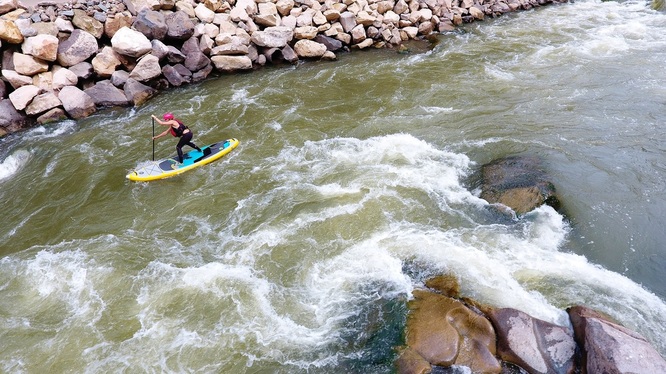|
With the increasing popularity of SUP, I have noticed that paddleboarding has become the primary introduction to the river for a lot of people. With this observation, and the fact that whitewater paddleboarders are going for paddling larger, more technical rapids, I feel that a post about river safety and a culture of preparedness is beneficial. I have a pretty extensive background in the outdoor industry, but I would love to hear any input from other paddle boarders on this subject. I started paddleboarding in 2012 on rivers. It is my passion. I graduated college with a Bachelor’s Degree in Outdoor Recreation Management, am a Wilderness First Responder, and Swift Water Rescue Technician, have experience as a river guide, SUP instructor, and retail at a paddle shop. If you are looking to get into paddleboarding on rivers, then I highly recommend starting off your research by reading this blog post by Ken Hoeve. The gear that Hoeve outlined in the post is absolutely essential for every river paddling expedition. But once you are hooked on whitewater SUP, know that there is much more to know about being prepared on a river. If you are leading river trips, please please PLEASE take the time to do your research and understand how to read a river and respect the river. This post is not a know-all say-all. The purpose is to enlighten you on what many experienced river paddlers are doing and preparing for in every single river outing. I fear that many river paddleboarders simply do not know, or become complacent of the power of the river. As I have learned throughout my NOLS and outdoor courses, we need to identify where we stand in the levels of competence and strive to become a Reflective Master, where we are open to learning and have the qualities of an expert with automatic competence. We do not want to fall in the category of a False Master who is competent but complacent, or someone who is unaware of their incompetence. I highly recommend reading the book by Nate Ostis called NOLS River Rescue Guide to get an idea of the culture of risk management on the river. I wanted to add to the list of gear that I believe should be essential in every river outing. In this post, I will cover river knives and releasable leashes. I have included links to my recommendations of items that I feel are suitable. River Knives:
I personally always have a knife on my PFD and advocate that everyone on the river should have at least one. There's a bungee cord or cam-strap on my SUP which could be an entrapment hazard. Also, using my knife is my backup plan if my releasable leash fails. Not to mention the fact that a poorly placed throw-rope could quickly turn into an entrapment situation. Wilderness Rescue International recommends having two knives: one on the outside of your PFD (make sure it has a blunted tip to avoid stabbing yourself or others in a rescue situation) and another collapsable knife in an inside pocket. Product Reviews/Recommendations:
Releasable Leashes: Assuming you are already aware of the debate on leashes and decide to use one (SUP culture is leaning more towards the benefits of a leash overriding the disadvantages), know that at this time there are two styles of release on the market. The Badfish Re-leash style and the releasable belt.
So that goes to show that if you thread your belt through the tri-glide, then you are practically eliminating the releasable components of your gear and putting yourself at risk. (Get your geek on about Rescue PFD's here: http://www.whitewater-rescue.com/aboutus.asp?id06=120) While I worked at a paddle shop, I met several people who were new to the river and wanted to purchase a Type V Rescue PFD. They wanted to have all the bells and whistles, but they did not know how to use them. Rescue PFD’s are awesome, and eliminate the potential of having your releasable belt slide around your waist, but if you do not know how to use the features of the PFD, please either take a swift water rescue course and learn how to use it, or opt for a more simple, Type III PFD Design (Astral Designs makes the Camino PFD, Layla, and Sea Wolf Type III PFD's that have the capability to include a simple releasable belt, perfect for SUPers!). Now, after all this talk on releasable leashes, maybe you decide to go with the Badfish Re-leash. Awesome, but let me mention a few points…
***I am excited for the 2017 release of Hala Gear’s releasable leash! It clips to your PFD using locking carabiners, utilizes a quick release clip and has the capability of converting into a regular ankle leash for when you’re in flatwater or ocean. I am so stoked to take it to the test and think it will be a great combination of features to be one of the top leashes on the market. For the sake of keeping this post relatively short, I’ll finish up with that. Let me know what your thoughts and experiences are with river SUP gear! I’d love to hear your feedback. Also, what are your thoughts on pin kits and throw bags? Are you guys taking those on the field every time? If so, what are your weapons of choice? |
Archives
September 2019
Categories
All
|

 RSS Feed
RSS Feed